The wall has faces
- 07/05/2021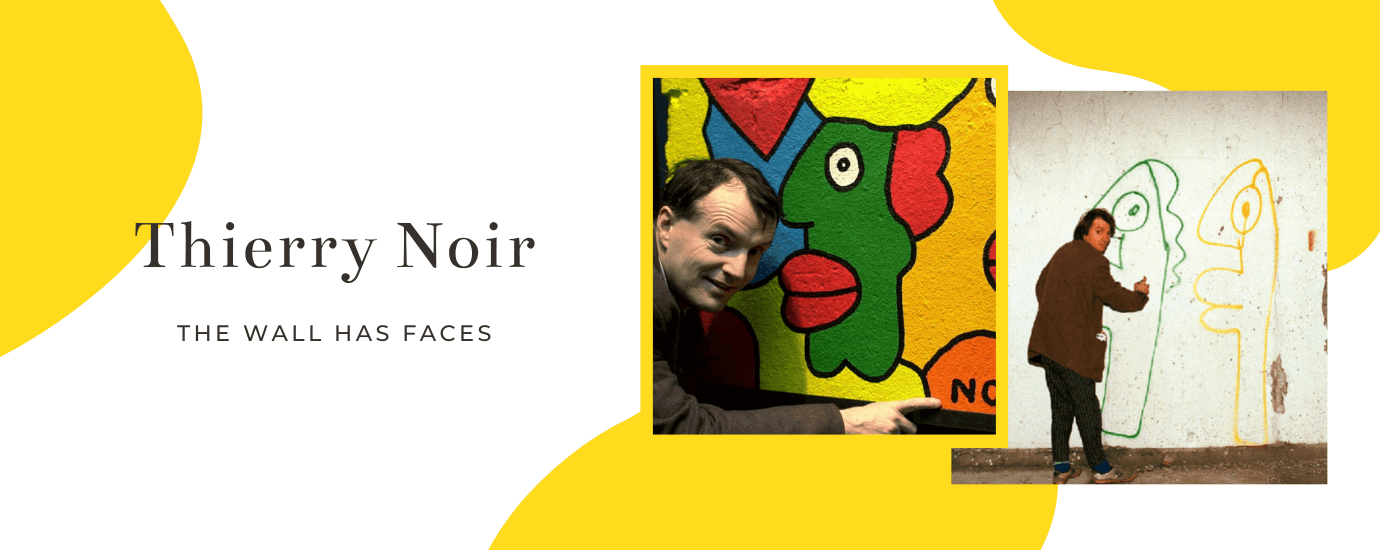
Fired for the umpteenth time, this time by the Regional health insurance fund for having taken material and drawn small dogs in meeting room, he decides "by desire of change and necessity" to try again in Berlin.
As seen from Lyon, it is the city where everything is possible:
it is the golden age of the Neue Deutsche Welle (the New German wave), the punk scene is bubbling, David Bowie and Iggy Pop, installed on the spot, swim in a powerful creative emulation, and there is this movement of squatters in open confrontation with Mayor Richard von Weizsäcker and the local police.
Fascinated by this protesting atmosphere and this alternative artistic frenzy, Thierry Noir gets by train to this magnetic city.
But on January 22, 1982, as he put his feet and two small suitcases on the floor of the Zooligischer Garten Bahnhof, the central station where he landed early in the morning, he realized that he had neglected that West Berlin was a Western islet smothered in the Soviet bloc.
The icy air and the effluvia of urine insistently made him think to go back "If I could, I would have left again in the day but I had no money and no return ticket, so I stayed" 30 years later, Thierry Noir is installed in an immense artists' studio in Kreuzbergstrasse, south of the German capital, where he is considered by a whole generation of young European artists as one of the street art popes and of the mural fresco for having dared, one day in 1984, to put a brush on a piece of damned concrete...
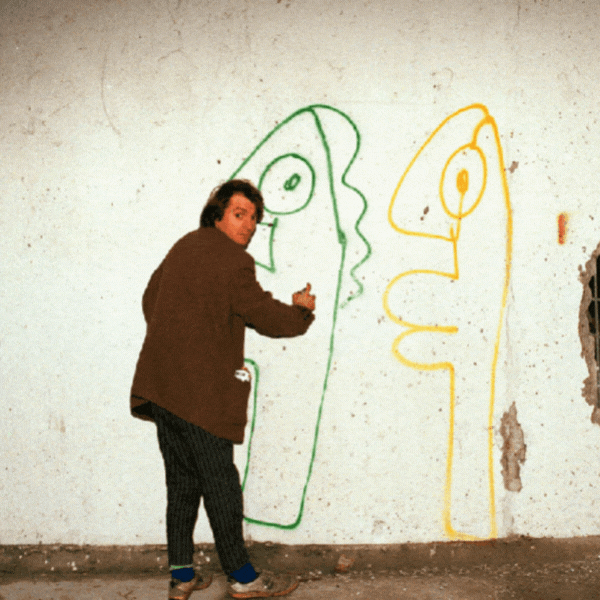
LOU REED, THIS LIAR
While he was tempted by stories about this attractive and electric Berlin, he is guided blindly in the heart of the Kreuzberg district by the words of a Lou Reed song who says "In Berlin, by the wall, you could hear the guitars play, it was so nice, it was paradise".
It was along this wall that he learned very quickly at his expense that the singer of Brooklyn never set foot in Berlin and that his song was in fact only a sweet utopia.
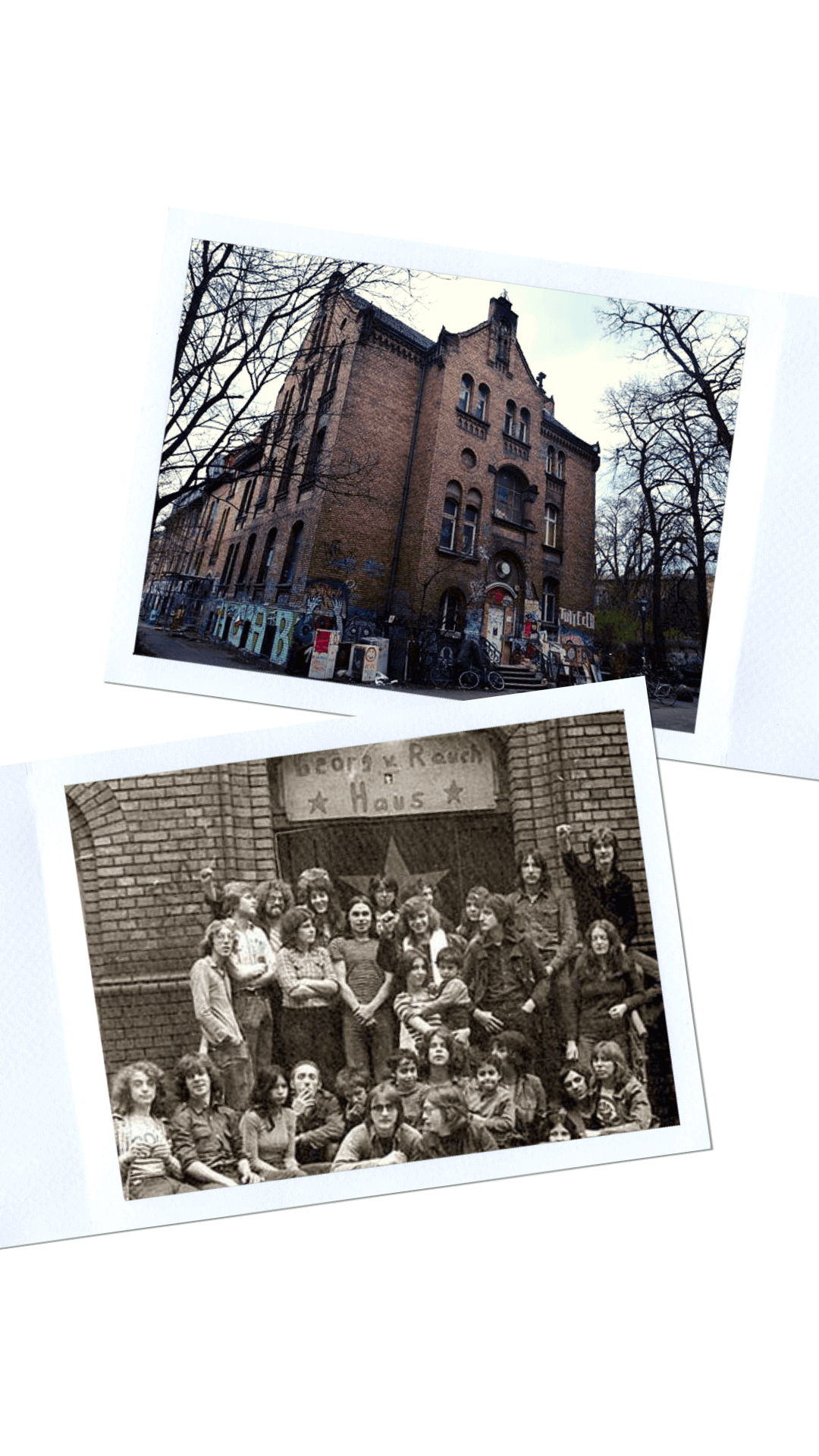
It is in this dubious corner of yellow brick, inhabited by fifty young artists, partly destroyed by the war and looking like a garage that Thierry Noir will change his life.
ARE YOU AN ARTIST? YES.
In this neighborhood abandoned by "normal people", he changes dimension:
"I found it extraordinary: in twenty years in Lyon I met one artist and there, in a week in Berlin, I knew dozens."
Thierry Noir then lives next to the famous Wall and his encounter with The Concrete Monster does not impress him.
Despite his height of 3.60 meters, he imagined the structure so much larger and more imposing.
In spite of the many upheavals he has just given to his life, the boy of Lyon quickly gets the Berliner Krankheit (disease of Berlin), this evil which obsesses the inhabitants of West Berlin who want to escape.
The air tickets are overpriced, the endless roadside checks and prospective of getaways are starveling.
One day, he is questioned in the street and asked if he is also an artist.
Considered as little gifted by his professor of handicrafts in France, he replied in the affirmative by advancing that he made music, poetry and a little painting.
"That's how my career started: pushing my possibilities to 120% to prove that I, too, was an artist."
Thierry Noir finds himself singing in a group, he draws and sells postcards in cafes, but it is a meeting that will strengthen his nascent vocation.
Christophe Bouchet, a young Frenchman like him, is expelled from his apartment Chamissoplatz and finds refuge in the Georg von Rauch Haus.
The artistic consciousness of Bouchet is more asserted than the one of Noir:
he made the Fine Arts.
The two men became friends and began to team up.
Scared by the proximity of the Wall, they decide one night in 1987 to go and paint a piece of concrete just behind their home.
"I did what I knew how to do, that is to say, not much! I did the drawing I had made in Lyon a few years earlier, which had me being fired from my Social security job."
If the Wall is far from being an immaculate canvas, many graffiti or coarse inscriptions adorn it here and there, no one had yet painted the structure in all its height and this is what Noir and Bouchet are going to do.
"AN UGLY WALL OUTSIDE OUR DOOR"
The district of Kreuzberg, frozen since the Second World War, is sprinkled with subsidies.
From their windows, Christophe Bouchet and Thierry Noir observe the ceaseless ballet of architects and workers and, every night, at the wheel of their 4L, they go around the yards to take the pots of abandoned paintings.
"Little by little, we began to store a lot of material: pieces of wood, brushes, pigments..."
Well-equipped, the two friends begin to paint the Wall every night in a funny frantic merry-go-round.
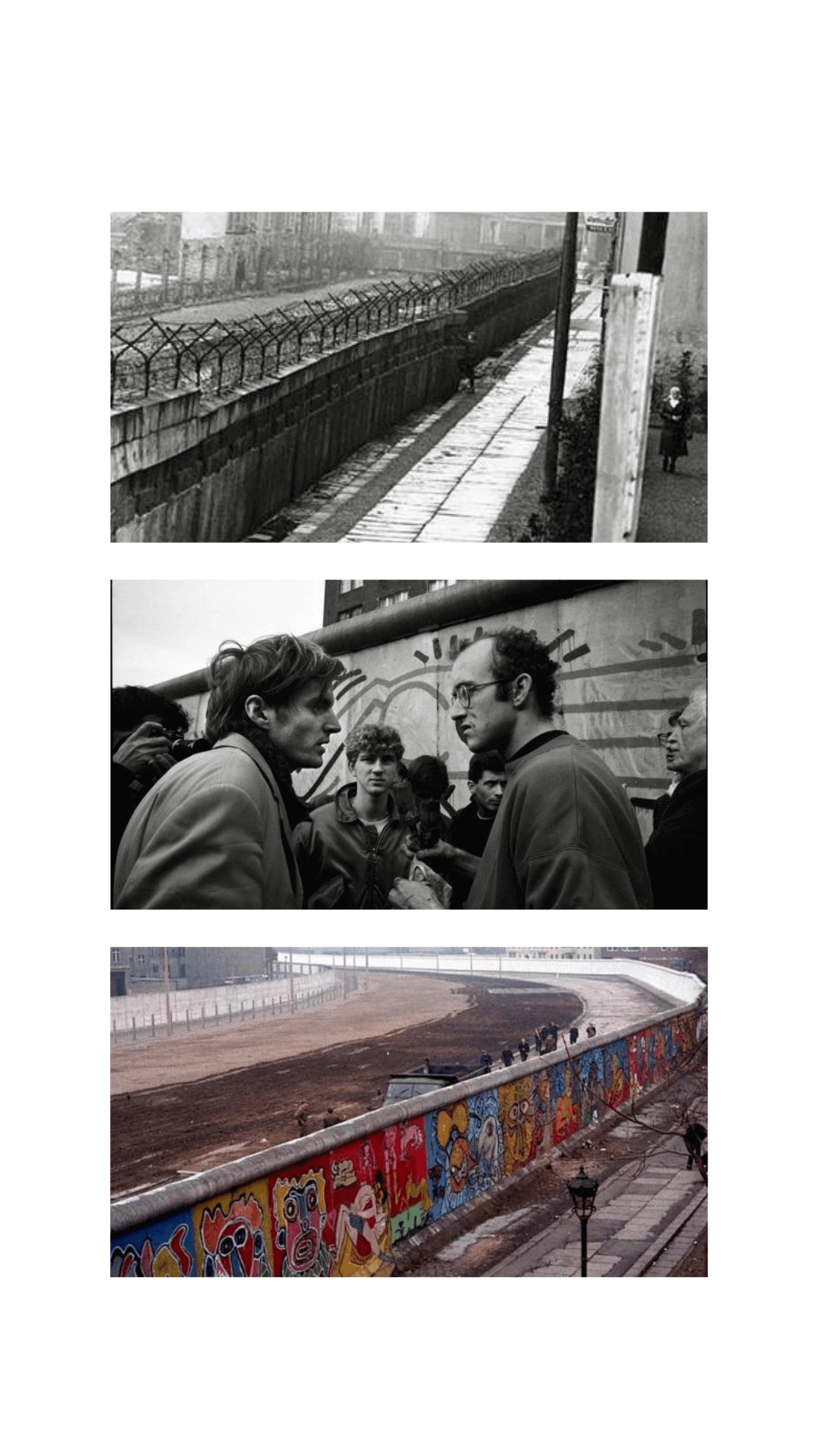
Without any particular goal, Thierry Noir explains to paint "just because it is an ugly wall in front of our door".
One evening, they risked paying tribute to Marcel Duchamp by fixing on the Wall an imposing door and a bidet.
While the latter is placed, the metal door awakens, in a deafening noise, the interest of the border guards who come in armed numbers, with dogs and vehicles.
Although the two sassy have gotten away, they know they are spotted and photographed.
Now they will no longer hide and will operate in daylight.
THE WALL OF TABOOS
Beginning so years of hide-and-seek with the Grenzpolizisten:
with each noise of ladder, with each step or with each threat from them, they spin abandoning their mural painting for a few hours.
For Thierry Noir, finally, more than the "Grepos", it is the passers-by who bother him when he paints on the Wall.
"The Berlin Wall was a taboo in German society, and to paint it was to break this taboo. Being French, I was not really concerned with all these issues. I did not realize that the reactions could have been so virulent. The neighbors, the passers-by ... all were shocked to see that I painted large colored frescoes on the Wall, some had already made small drawings, but what I did there was completely new. Often, I had to stop painting, I had to explain myself to the others over and over again. In the end, I spent more time talking than painting!"
Slaved by all these constraints, Thierry Noir's style was purified to become more efficient:
he then invented a painting per kilometer and found his signature with gigantic figures, childish in bright colors with big eyes and a big mouth.
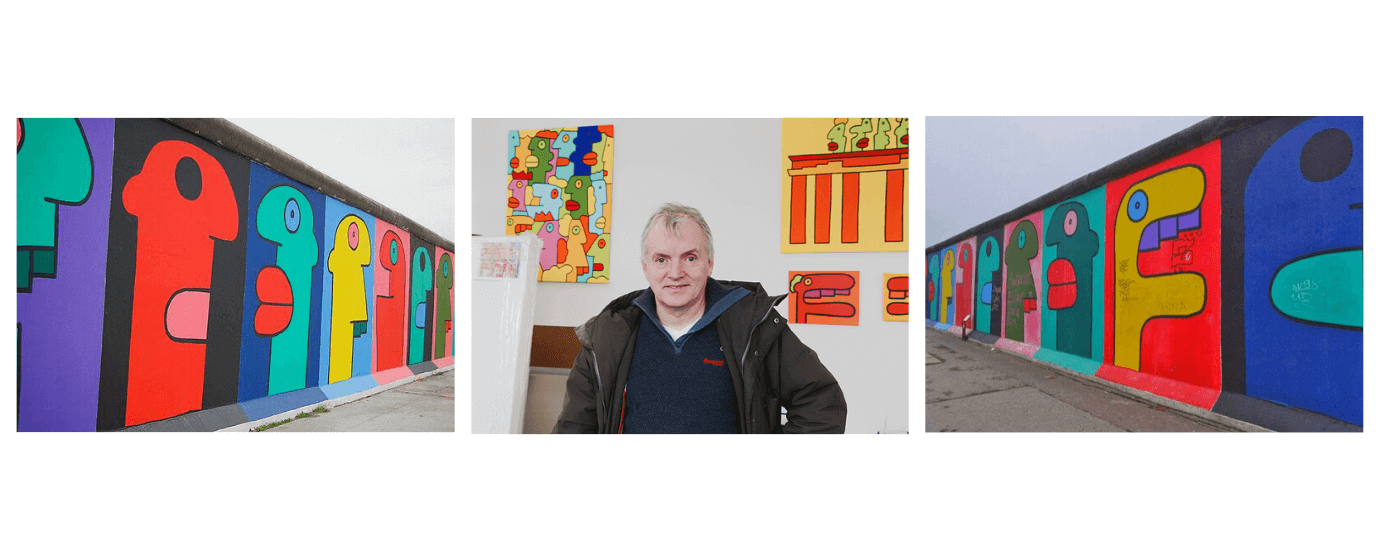
FROM BERLIN TO YOKOHAMA
While its frescoes disturbed, they finally attracted the eyes and sympathy of the people in 1987.
The success of the film of Wim Wenders, The Wings of the desire is there for something.
The German filmmaker decided to make the frescoes of Thierry Noir appear at the key moment of the film, when the image passes from black and white to color.
While he is no longer the only artist of the Wall, Noir's approach arouses a growing exaltation:
passers-by and even American soldiers are photographed in front of his paintings.
While a wind of change blows on a Europe tired by years of cold war, on 9 November 1989 the Wall falls.
For Thierry Noir, it means the destruction of his work, but he does not see it as a tear but rather as a relief.
"Finally, I could take my daughter to kindergarten in this park that was previously inaccessible and yet right in front of my house."
The Wall dismantles itself for months under the blows of pickaxe and hammer of the Berliners.
Breaches are created and the opportunity is too good for Thierry Noir who begins to paint the other slope of the Wall completely virgin, and for good reason, it is located on the old track of the death on the lands of Grepos.
While they are delighted by dropping this concrete snake that has scarred their lives and their city, the Germans do not immediately understand that they are destroying part of their history.
Fragments of the Wall were reduced to dust while others were recovered and sold for delusional sums in the four corners of the world.
Some of the pieces of Wall painted by Thierry Noir are found in Cap-Ferrat, Tokyo, Yokohama, Los Angeles, Mexico or Budapest...
Noir, who fought a great part of his life for this Wall to fall, hopes now to save what remains of it in Berlin.
The East Side Gallery, open heart memorial, is threatened by a large-scale real estate project.
For Thierry Noir, "people died behind my paintings. If one forgets his past, he can come back later."
THE NEO-COLLECTOR'S GUIDE
Everything you always wanted to know about the art market but were afraid to ask!
The art market often appears to be a domain reserved for a privileged few...
This is not true: accessible to all, the art market is only waiting for its new collectors.
For those who still have a doubt :
Here are the answers to the questions commonly asked!
What is a work of art?
What is the purpose of art?
What is the purpose of a certificate of authenticity?
What should you look out for when buying a work of art?









.png)






